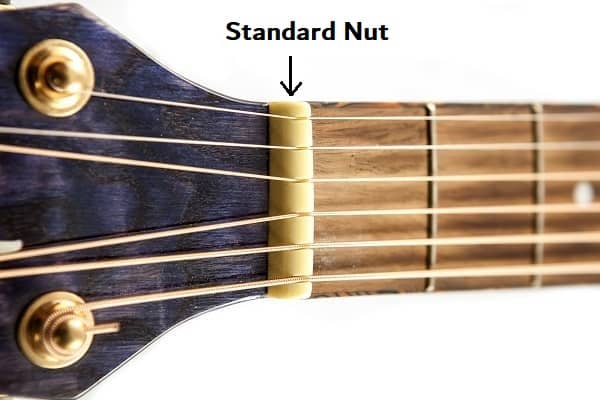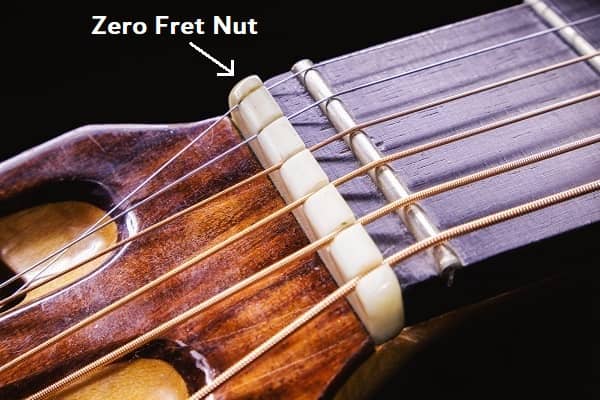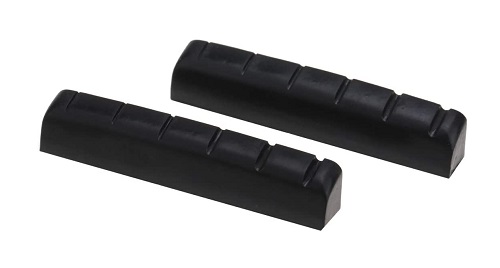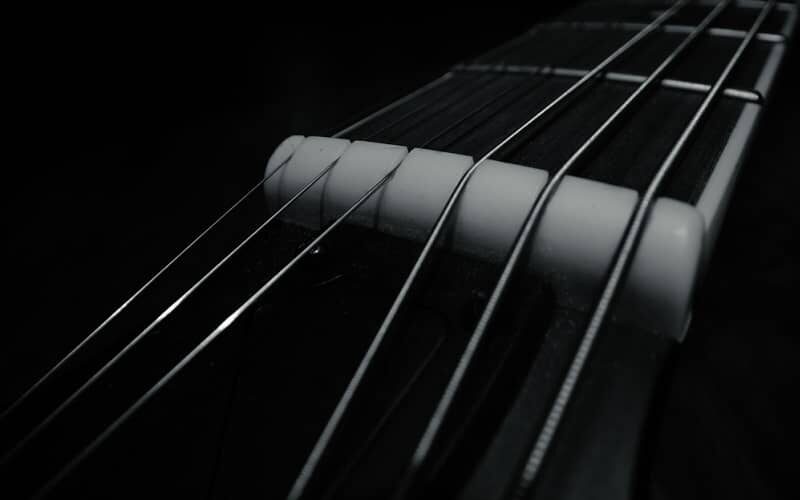If you’re new to the guitar, or a beginner to intermediate guitarist looking to purchase your first higher quality instrument, you’ve probably heard the term “nut,” and may be wondering what it means.
Don’t feel bad; many beginner guitarists, even those familiar with most of the basic components of a guitar, can’t name this piece of hardware, or describe the various functions it serves.
It usually isn’t until a burgeoning guitarist has outgrown their beginner instrument and is shopping for an upgrade that the importance of the guitar nut becomes evident.
Once a musician understands the effect of a guitar nut on the instrument’s tone and playability, they will almost always consider the nut style and the material of each guitar they consider adding to their collection.
What Is A Guitar Nut?
A guitar’s nut is the thin bar of bone, or comparable material, positioned between the instrument’s neck and headstock. The nut is the last place the strings make contact with the instrument before reaching the tuning knobs and is most often off-white or black in color.
The nut of a guitar is fashioned with grooves, the number corresponding to the number of strings on the instrument. A standard six-string guitar nut will have six evenly spaced grooves cut into it; the strings rest in these grooves, keeping them the proper distance apart.
Why Is A Nut Essential?
The guitar’s nut plays an essential role in the instrument’s playability; without a nut to keep the strings evenly spaced and at the right height above the fretboard, fingering chords and sounding consistent notes would be next to impossible.
Are Acoustic And Electric Guitar Nuts The Same?
Electric and acoustic guitar nuts perform the same functions and are, generally speaking, the same. The primary difference between acoustic and electric guitar nuts are their size.
Acoustic necks are wider than electric guitar necks, and acoustic guitar strings are thicker than electric strings; therefore, acoustic guitar nuts are larger, and have larger grooves, than electric nuts.
Different Types Of Guitar Nuts
Generally speaking, there are five types of guitar nuts: the standard nut, the compensated nut, the locking nut, the roller nut, and the zero-fret nut.
Understanding the different types of nuts is essential when making an informed guitar purchase, so let’s take a look at how each type functions.
Standard Guitar Nut

By far, the most common type of guitar nut is the standard nut. Found on the majority of guitars regardless of price, standard nuts are fashioned of materials ranging from bone to metal to synthetic plastics.
The material of the nut makes a difference to a guitar’s playability and tone, and we’ll look at nut materials in more depth later.
Compensated Guitar Nut
On a guitar with a standard nut, the distance between the first fret and the point where the string contacts the nut is the same for each string. A compensated nut, on the other hand, is designed to stagger this distance, thereby providing better tonality, particularly when fingering notes on the first few frets.
Locking Guitar Nut

If you’re a fan of hard rock, metal, and progressive guitar, odds are you’ve at least seen a guitar with a locking nut. Favored by musicians who make frequent and often dramatic use of their whammy bars, locking nuts are designed to keep a guitar in tune through the likes of Jimmy Hendrix or C.C. Deville-styled dive bombs.
On a locking guitar nut, small clamps hold the strings firmly in place at the nut position. When a guitar’s strings are all “locked” by the nut, turning the tuning pegs will no longer affect the guitar’s tune; necessary adjustments are made via the guitar’s bridge.
Roller Guitar Nut
Popularized by Fender, roller guitar nuts are another innovative spin on the standard nut. Instead of the guitar’s strings resting in slots carved into the nut, on a roller nut they each rest against a small ball bearing; this reduces any friction or pinch at the nut groove, which helps keep the instrument in tune.
Zero Fret Guitar Nut

The last type of nut we’ll discuss is the zero fret nut. Some guitars, notably those used to play gypsy jazz, are fashioned with what’s called a “zero-fret.” This innovation causes open notes to sound as though they’re being fingered.
On guitars that have a zero-fret, the nut serves as little more than a spacer for the strings; the zero-fret itself serves as the string’s point of contact.
Guitar Nut Materials
Though it may seem little more than a minor, if necessary, guitar component, the nut is actually more important than a beginner guitarist may think. The material a guitar’s nut is crafted of affects not only the instrument’s playability but, to a greater or lesser degree, its tone too.
There are six basic types of guitars nut material, each with its own pros and cons. Let’s take a look at each type and see how they affect a guitar’s playability and tone.
Bone
For many guitarists, bone represents the high-water mark for guitar nuts. Featured on many vintage guitars including Fenders, Gibsons, and Martins, bone nuts produce vibrant, bright tones.
Tonal quality isn’t the only advantage bone has as a nut material; bone is also very easy to work with. Angling and slotting a bone nut is often easier than fashioning a nut of other material.
Bone is also self-lubricating, a huge advantage when it comes to materials for guitar nuts. A lubricated nut allows the strings greater freedom to return to their proper place and pitch, helping to keep the instrument in tune.
As superior a nut material as bone is, there are some drawbacks. For example, bone is a natural material that often contains inconsistencies. Softer pockets within a bone nut might conceivably affect a guitar’s playability and tone.
Bone is a popular nut material and is readily available on Amazon. For example, the Blisstime Acoustic Guitar Bone Bridge Saddle and Nut, a best-seller on the site, goes for under eight dollars.
Fossil Ivory
Fossil ivory is considered by many guitarists to be the next best choice in nut material. Offering a tonal quality similar to that of bone nuts, fossil ivory nuts are less common than bone because fossilized ivory is harder to come by.
Harder and more brittle than bone, fossilized ivory can be difficult to work with.
Plastic
The vast majority of beginner guitars come with plastic nuts. Plastic nuts don’t offer the tonal quality of other, superior nut materials, but they work just fine and help keep the cost of beginner instruments affordable.

Of course, there are good reasons more expensive instruments don’t use plastic nuts. Aside from being an average sounding material, plastic is brittle and not particularly easy to work with.
Not all plastic nuts are the same, though. There’s a huge difference between the ordinary plastic nuts described above and higher-end synthetics designed to mimic bone, like TUSQ, Micarta, and Corian. Far superior to ordinary plastic, these synthetics are self-lubricating, easy to work with, and provide great resonance.
Guitar nuts fashioned of high-quality plastics like TUSQ are a bit more expensive than nuts made of other materials; Graph Tech makes TUSQ guitar nuts ranging in price from around twelve dollars to around twenty-two dollars, most of which are available on Amazon.
Metal
Though less common than bone or plastic, metal (usually brass or steel) is another nut material. A guitar with a steel or brass nut will produce a brighter sound with more harmonic tones than guitars with other nut materials.

Popular in the seventies and featured on Danelectro guitars, among others, metal guitar nuts quickly fell out of favor. Partly, this is because metal is an average sounding material when compared to other materials, like high-quality plastic or bone.
Another reason for the metal guitar nut’s decline in popularity is it can be difficult to work with and cut.
Graphite
If you’re a player who, like Jeff Beck or Adrian Smith, incorporates a lot of whammy bar into your style, you’ll want to consider a graphite nut for your guitar.
Graphite is a self-lubricating nut material, which translates to better fine-tuning stability and reliability. Lubricated slots allow the strings to pass back and forth with minimal surface friction.
Graphite nuts are easy to come by and relatively inexpensive. For example, a two-pack of Pre-slotted Metallor Six String Graphite Guitar Nuts will run you only eight dollars on Amazon.
A good graphite nut offers a consistent, smooth guitar tone; they’re also reasonably easy to cut and shape, making them a popular choice among guitarists in the know.
Ebony
Ebony is another great option for a guitar nut. The two main draws of ebony as a nut material are that it looks and sounds great. Not only does ebony give your guitar a stand-out look, but it also helps provide great overall tone.
Though it may not sound quite as good as bone or fossil, ebony is a relatively inexpensive way to get a sound that’s comparable.
Frequently Asked Questions
What Is The Best Nut For Guitar?
The best type and material nut for any guitar is largely a matter of personal preference. That said, few, if any, guitarists will argue that ordinary plastic or metal nuts are superior to the other types.
Which guitar nut is right for your instrument depends on a few factors, such as the sound quality you’re looking for, your style of playing, and your budget.
For example, a rocker who’s heavy on the whammy bar will likely prefer a guitar with a graphite nut, if not a Floyd rose tremolo system and locking nut. A guitarist on a budget, on the other hand, might find an ebony nut best suits their needs.
How Much Does It Cost To Replace A Guitar Nut?
Replacing a guitar nut isn’t an expensive proposition; in fact, depending on the types of guitar nuts you’re considering, a replacement should cost between five and ten dollars, on average. That said, some nuts, like titanium or metal roller nuts, can cost as much as twenty-five or thirty dollars.
While it isn’t expensive to buy a new guitar nut, having it replaced professionally will set you back anywhere from sixty to one hundred fifty dollars. Ultimately, the price will depend on how much work it takes to remove the old nut, clean the groove, and make any necessary modifications to the new nut.
Swapping guitar nuts isn’t rocket science, and experienced guitarists–or those good with their hands–shouldn’t expect too much difficulty. If you’re a beginner guitarist or, like me, happen to be all thumbs, having your guitar’s nut replaced by an experienced guitar tech or luthier is well worth the money.
An improperly set guitar nut will adversely affect the instrument’s playability and tone; if the nut is set too low, you’re also likely to experience string buzz.
How Do I Know What Material My Guitar Nut Is?
It takes more than the naked eye for most guitarists and even guitar techs to identify what material a guitar’s nut is fashioned of; bone, plastic, and TUSQ nuts all look similar. There are a few tricks, though, to help you identify what material guitar nut you have.
The first way to determine guitar nut types is to look at the price of the guitar in question. Beginner guitars almost always come with plastic nuts; it’s one of the ways manufacturers are able to keep prices down without severely compromising sound or playability. If your guitar is a beginner model, or under five hundred dollars, odds are it has a plastic nut.
If you’re trying to determine the guitar nut types of more moderately priced or vintage guitars, there’s a trick you can use to make life easier. Most guitarists agree the best way to determine nut material is to file the nut in an inconspicuous place. Different guitar nut types react differently to filing; how the material reacts–and the odor it produces–can tell you what you’re working with.
A bone nut will give off an odor like burned hair when filed; an odor of burning plastic will, likewise, tell you all you need to know. When filed, bone will chip away; TUSQ materials file smoothly, and plastic will melt.
About the Author
Thomas M., the founder of Guitar Top Review, boasts 15+ years of guitar experience and was a church band member in L.A. Transitioning from piano to acoustic guitar, his first love remains his Taylor GS Mini. Alongside like-minded hobbyist friends, he launched the site, driven by a deep love for music that transcends professional boundaries.




